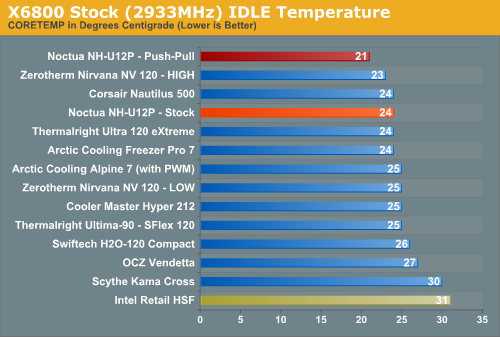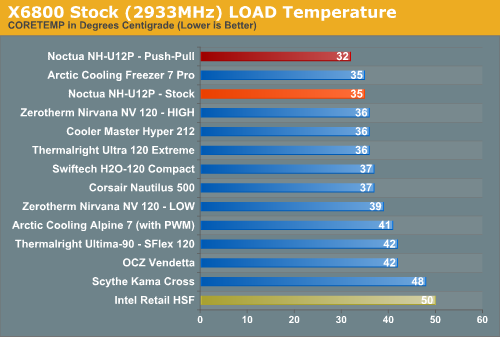Noctua NH-U12P: Top Performance AND Silence
by Wesley Fink on March 20, 2008 8:00 PM EST- Posted in
- Cases/Cooling/PSUs
Cooling at Stock Speed
Some users will never overclock their CPU, but they still want to run the coolest CPU temperatures possible to enhance stability and extend CPU life. We compile all temperature benchmarks with CoreTemp, a public domain utility that is quite stable with reproducible results on the Intel platform.

Performance at stock idle with the Noctua NH-U12P matches the best we have ever measured at AnandTech. When we tested with two of the new NF-P12 fans in a push-pull configuration performance actually dropped to ambient room temperature. This is an amazing level of performance, and it is the best result we have ever seen with any normal cooler under any conditions.
Where the very good Intel stock air-cooler keeps the X6800 at 31C at idle, the push-pull NH-U12P reduces that to 21C. This compares to the top Thermalright Ultra-120 eXtreme at 24C, Corsair water at 24C, Swiftech water at 27C, and ZEROtherm Nirvana at 23C. In comparing results, please keep in mind the test results from the new cooling bed using CoreTemp are not directly comparable to earlier cooling results.
It is more difficult to simulate all the various stress conditions a computer may encounter in different operating environments. For most home users, contemporary gaming is one of the most demanding CPU (and system) applications. Therefore, our stress test simulates running a demanding contemporary game. We loop the Far Cry River demo for 30 minutes and capture the CPU temperature with CoreTemp's "logging" option. We report the highest temperature during the load test. Momentary spikes are ignored, as we report a sustained high-level temp that you are likely to encounter in this type of scenario. This test configuration roughly equates to an 80% CPU load test using Intel TAT, another respected program for thermal measurements.
Let's compare cooling efficiency of the Noctua NH-U12P under load conditions at stock speed to the retail HSF and other recently retested CPU coolers.

The NH-U12P turns in an outstanding performance under load at stock speeds. CoreTemp results are 35C, which again represents the best air-cooling result so far at AnandTech. Performance with two fans in a push-pull configuration is even more impressive, yielding 32C under load. This exceeds our previous best load results at stock by 4C, which is impressive considering the competitors. This is a 15C to 18C improvement in cooling under load compared to the stock Intel fan, which reaches 50C under load at stock speed in our cooling test bed.
Cooling results with the Noctua NH-U12P at stock idle and load are record setting. Test results are the best we have ever seen - matching the top Thermalright Ultra-120 Extreme - or coming in a bit better - with the stock single fan. With two fans, the NH-U12P outperforms anything we have ever tested at stock speed.










51 Comments
View All Comments
poohbear - Monday, March 24, 2008 - link
im going on previous cpus that overclocked upto 70%, currently the wolfdales that go from 2.6 to 4ghz are'nt a 50% overclock, but still bloody impressive. My opty 165 goes from 1.8-3.0ghz, which is a 66% overclock.:)Nihility - Friday, March 21, 2008 - link
I thought the F7P had terrible build quality, at least that's what I hear from the reviews on newegg.RamarC - Saturday, March 22, 2008 - link
many newegg reviewers are idiots.i've had two f7p's for the past 14 months. problems: zero; performance: fantastic. anything that can keep a pentium d 945 in the 50s under load and not sound like a f'n jet engine is fantastic in my book. and my e6600 @ 3ghz peaks in the low 40s with the fan spinning at only 800rpm.
JarredWalton - Sunday, March 23, 2008 - link
Yeah, we pretty much http://www.anandtech.com/casecoolingpsus/showdoc.a...">found the same thing in our review. No, you're not going to match the Thermalright Ultra-120 eXtreme, but then at 1/4 the cost you can't complain too much. The F7P is substantially better than retail HSF in noise levels and performance, at a cost of http://www.ewiz.com/detail.php?p=FAN-AC7PRO">$20 shipped.Syzygies - Friday, March 21, 2008 - link
I too have a Thermalright U120E push pull, using a pair of Scythe S-FLEX SFF21F fans, in an Antec P182 case decked out with other fans. I too used cable ties: One can fashion a pair of four-sided harnesses, using four cable ties each. Size them almost to fit, trimming so there's still a bit of plastic to pull on, then gingerly tighten a click at a time to snug, for a perfect fit.Anandtech has the best air cooling reviews, period, lending much-needed credibility to any comparisons with water cooling. In contrast, another site has a water cooling review that cools a 3.2 GHz Q6600 to 58 C to 62 C at full load, comparing favorably with a Zalman 9700. Those are exactly the numbers I'm getting with my U120E, and I'm getting nowhere on that forum pointing out how cooked the review looks.
For those of us trying to wring every advantage from air, we're unlikely to use an "average" case, and we're likely to consider lapping. Besided returning the U120E to the ring in push pull mode, those are my questions.
silhrt - Friday, March 21, 2008 - link
Back on the Noise Levels page, I noticed that at 6", 7 of them were at the same and at 24", 9 of them were at the same level. Rarely, if ever, are these tests with so many the same. ( not even .1 differenece ) So, this leads me to wonder if the method of testing is accurate.Is there any way to get a sensor that reads below 30? Maybe near 20?
Since its at the low end of the sensor, maybe its bottoming out?
Wesley Fink - Friday, March 21, 2008 - link
As clearly stated in the review those noise levels are the noise floor of the test system, which is equivalent to a suburban bedroon at night. Since we are running a varaiable speed low-noise power supply and fanless video card these levels represent the quietest power supply we could find that also realistically supports overclocking. The video card is fanless and zero noise.We don't test or try to measure even lower levels because that is not the way people actually run their systems. If you are interested in the noise level of a component in isolation with a power supply in another room there are other web sites that will provide you that information.
a09805 - Friday, March 21, 2008 - link
I would not blame the sensor.I guess the problem is a higher-than-desired ambient noise. There's evidently something else in the testing room that shouts in the background, and that covers the whisper of the fans. We need a more silent environment to compare noise from a fan or two. Also, we should measure noise at about 1m, that would be a typical real-world minimum distance.
For some serious thoughts and hints about silent computing visit www.silentpcreview.com.
woofersus - Friday, March 21, 2008 - link
So when are you going to slap that fan on a the big thermalright? Best fan meets best heatsink? Could be a match made in heaven even without push-pull..Wesley Fink - Friday, March 21, 2008 - link
You read our mind - or at least the hints in the Final Words :) We'll be doing it soon.